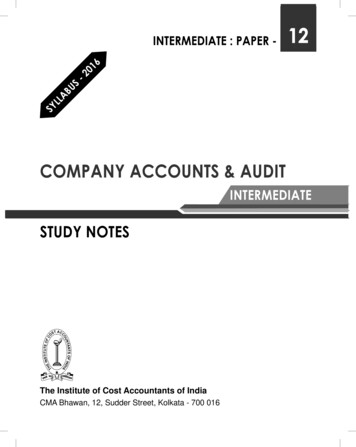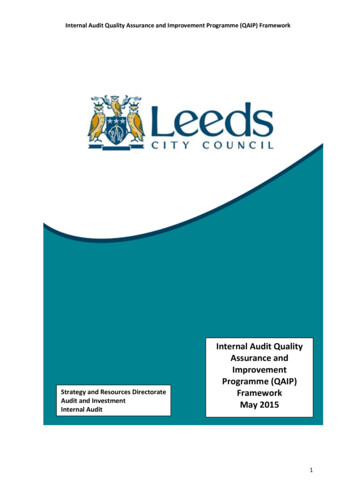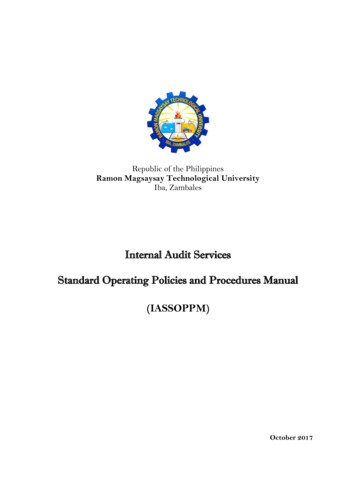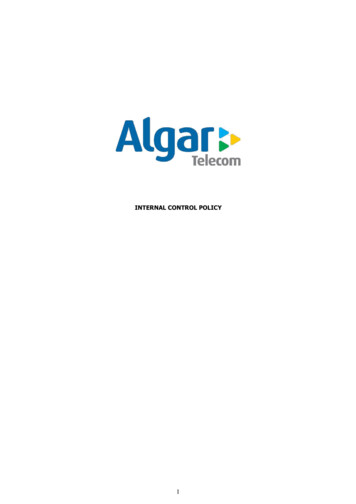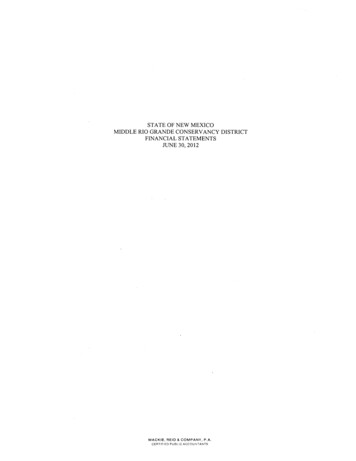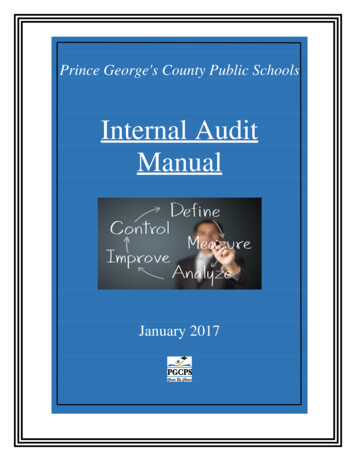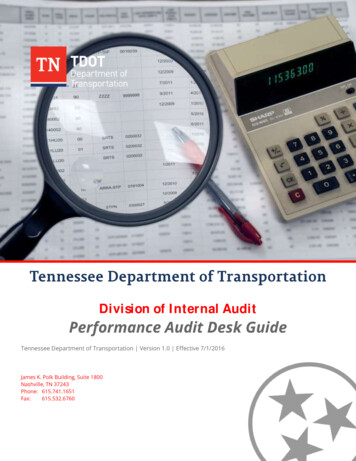
Transcription
Policies, Procedures, and Audit GuideDivision of Internal AuditPerformance Audit Desk GuideTennessee Department of Transportation Version 1.0 Effective 7/1/2016James K. Polk Building, Suite 1800Nashville, TN 37243Phone: 615.741.1651Fax:615.532.6760
Audit Project Management and Audit Process FlowGeneric OutlinePerformance-Operational AuditThe following audit program provides suggested steps to enable a moderately experiencedauditor to complete a performance/operational audit and meet the required yellow bookstandards. It is important for the auditor to recognize that the suggested steps are shells tohelp internal auditors develop their engagements-specific procedures when performing aperformance/operational audit.The processes enumerated herein should be utilized in conjunction with the internal audit howto- guides as well as the internal audit policies and procedures manual. Auditors can utilizeother available practice aids for particular areas in the fieldwork phase as necessary.AUDIT PROGRAM PURPOSE AND SCOPEThis program has the following major points: Provides a general engagement project management guideEnables the auditor to understand the nature the organization’s objectivesFacilitates understanding of the organization’s various operationsAids in performing preliminary analytical procedures and evaluating the resultsHelps Identify relevant operational risk factorsHelps in Identifying significant compliance requirementsDeveloping the risk register and documenting the internal control assessmentRefining and developing granular audit objectivesFacilitates the design of the testing protocol(s)Guides the auditor in interpreting and summarizing resultsProvides the appropriate sequence for reporting the outcome of the engagementSensitivity, Centrality, and MaterialityTDOT Office of Internal Audit2
I.Preplanning/Pre-Engagement Activities - are audit engagement activities that an auditormay perform even before the Director formally announces the engagement. These activitiesnormally include obtaining internal and external information regarding the subject matterof the audit.Purpose: The purpose of this procedure step is to gain a general knowledge of the operationunder auditObjective and Goal(s): The objective of this procedure step is to prepare project managementdocuments, ensure project independence status, and conduct a preliminary informationgathering about the subject matter of the audit.AUDIT CHECKLIST1What to do:Create an Entrance Conference Agenda using the standard formatlocated in the internal audit library.2Submit the entrance conference agenda to either the audit director or theprincipal auditor for review and approval.3Assess auditor independence using the GAGAS conceptual framework forindependence; note any potential independence threats and notify theaudit director. If no issues arise after evaluating auditor independence,proceed to the next steps.4Prepare other project management documents such as projectindependent statements (do not date), budget (discuss with Director),protection of confidential information statements, sign-off statusworksheets, questionnaires (if any), surveys (if any), and Fraud RiskAssessment forms.Sensitivity, Centrality, and MaterialityTDOT Office of Internal AuditCheck-offReferences3
5What to do:Conduct a background information search using the Internet or otherinternal organizational sources; the purpose of this step is to obtain abroad knowledge of the subject of the audit.Check-offReferencesSeveral things that you would want to gain an understanding of: What is the nature of the auditee’s operation What is the primary objective of its existence What product(s) or service(s) do they deliver Can you ascertain the source of funding Are there published budgets, revenues, and expenditures for thisorganization Do they have published operating standards or reports Has there been any news regarding this function on the Internet? Ifso, what were the issues pertinent that became newsworthy What do others in the same industry perform? How similar ordifferent is this from the auditees operationYour potential information sources of information may include: Internet and IntranetLegislative rules, relevant legislation (new),and federal regulationsState policies and proceduresEntity rules and regulationsEntity manuals, field guides, desk guides, and P&P manualsPrior audits from other State Comptroller and other DOTsLibraries or Permanent RecordsTrade or Industry JournalsPublished reports from Consultant FirmsWhen reviewing audit reports, note what issues were prevalent duringthese engagements. If the audit pertains directly to your auditee, note theissues that were mentioned and inquire about its status when you have theopportunity. If this is an audit that was conducted on an entity that has asimilar function to your auditee, also note the issues that were encounteredby the auditors because there is a high likelihood that similar issues mayarise (given the similar activities) in your audit.7Perform a final review of the background material to become familiarwith the activities of the organization.6Compile the preliminary information that you have obtained and note anysignificant items that you may have observed from your pre-engagementactivities.Sensitivity, Centrality, and MaterialityTDOT Office of Internal Audit4
Reminder: did you perform the following? Prepare the necessary forms Obtain sufficient information about the audit subject matter to gain a generalknowledge about their activitiesOutput(s): Project management documentsExternal and industry information about the audit subject matterEntrance conference agendaInformation requests listSensitivity, Centrality, and MaterialityTDOT Office of Internal Audit5
II.Planning Activities - are audit engagement activities that an auditor performs after theentrance conference. These activities normally include obtaining internal/operationaland some external information regarding the subject matter of the audit. In this step,the auditors may also utilize surveys, questionnaires, and group meetings withorganization personnel to gain an understanding of transactional process flows, existinginternal controls, process inputs and outputs, exceptions, issues (both existing andimpending), and performance metrics.In this section, the auditors also discuss the entity’s activities from an operationalstandpoint noting any changes in the policy and procedures, employee turnover rate,and operational constraints.Purpose: To gain a working knowledge of the operation under auditObjective(s) and Goals: The objective of this procedure step is to gather pertinent informationregarding the audit subject matter. This is a more formalized approach then the scopingconducted during the preplanning stage. In order to comply with auditing standards, theauditor must demonstrate an understanding of the audit subject matter especially as theypertain to, (a) key activities performed, (b) organizational structure (c) financial flow resources,(d) regulations policies and procedures they need to follow, (e) key computer applications theyuse, and (f) the general workflow within the various business operations.AUDIT CHECKLIST1What to do:Obtain an organizational chart and gain an understanding of the variousactivities performed by the auditee. Within this area, there are severalthings that we need to understand and that includes the following: Check-offReferencesThe risks inherent to the operationThe key controls needed to counter those inherent risks andinfluential environmental aspectsWe need to learn about the management of the operation(management style and level of control)We need to understand how the organization conducts itsplanning, directing, and controlling activitiesHow does management find out about the work environmentDoes management have specific concerns about any area withintheir purviewLearn about the people performing the activities/operation Key personnel and their roles within the entityAre there written job descriptions for the staffWhat kind of staff training is givenWhat methods does management use to evaluate staff-Sensitivity, Centrality, and MaterialityTDOT Office of Internal Audit6
23What to do:Obtain financial information (management summaries, year-end reports,balance sheets, revenues and expenditure, and cash flow statements)regarding activities performed by the auditee.ReferencesGain an understanding of the auditees financial flow resources. The criticalelement in this exercise is to ascertain both the inflow and the outflow ofmonies. The auditor should endeavor to understand the following: 4Check-offDoes the unit or activity generate revenueWhat are the unit’s source(s) of revenueIn what form are revenues received (cash, checks, credit cards,electronic funds transfer, inter-agency transfers, etc.)Do they have a budgetWhat are the unit’s expendituresWhat are the current trends of their finances (perform a horizontaland vertical analysis)Gain an understanding of the auditees overall business operations byascertaining the following: What are the unit’s Mission and Vision statementsWhere do their inputs come fromWho depends on the unit’s outputAre there any time or seasonal constraintsAre there geographical constraintsAre there monetary constraintsWhat are the current trends for the operation (staff turnover, workvolumes, major organizational changes, etc.)Does the business unit have a formal business planDoes the business unit have a business recovery planDoes the business unit have standard operating procedures orpolicies and procedures manualsHow does the organization set its prioritiesWhat performance measures or indicators does the unit utilize tomeasure success5Ask management if they are aware of any historic or current instances offraud, waste, or abuse within their area of responsibility.6Develop a questionnaire for interviews and discussions. Arrange for theinitial meeting (set a cooperative, but no-nonsense atmosphere) andfacilitate an open-ended discussion allowing the interviewee to discusstheir own work processes. Note the following: Interview people involved in key activities of the operationThe interview should include a process walk-through of thatperson’s job tasksAllow the interviewee to explain their workflow by asking them theSensitivity, Centrality, and MaterialityTDOT Office of Internal Audit7
What to do:question,” How the work move into and out of your desk?” (area ofresponsibility) Try to be sufficiently transparent by allowing the interviewee todemonstrate the actual process of an activity from input throughthe final output Inquire about exceptions and how are they handled Ask the interviewee who performs the work in their absence Obtain example documents and/or copies of outputs If necessary, obtain access to files worksheets and databasescontaining audit information If necessary, obtain copies of worksheets and databases (youmay need this to conduct preliminary analytical procedures) Note how the process of this key individual contributes to meetingthe overall objectives of the organizationCheck-offReferencesDuring this time, it is imperative that the auditor note any inconsistenciesbetween the stated and observed procedures. In addition, the auditor mustnote any observed internal control issues such as inadequate segregationof incompatible duties, lack of supervisory review, reconciliations notperformed, inaccuracies in input information, inaccuracies in outputinformation, management overrides, and other potential internal controlissues.7When you have developed a good picture of the entire process flow and allthose who are involved in the process, document your understanding bycreating a process flow narrative or creating a flowchart visualization of theprocess.It is essential that we document the process flow as we have observed itand not as it is supposed to be. This is the only way that we can ascertainwhether a variance exists between the expected and the actual outcome.Once a process flowchart is complete, present it to the client and walk themthrough the process. If there are any discrepancies, make the necessarycorrections and present the revised version to the auditee one more time.Once there is congruence between the parties, ask the auditee toacknowledge the flowchart, sign, and date the document, and provide theauditee with a copy.Notes:1. Ideally, the best way to map a process flow is to have all theplayers present in one room while mapping the entire activity. Inthis way, you can receive accurate input directly from the folks thatare conducting the work. However, in real-world instances, it is farmore difficult to get people together to conduct this process.2. Whenever documenting a particular process flow, note the time ittakes to perform each steps as well as the time elapsed betweeneach step.Sensitivity, Centrality, and MaterialityTDOT Office of Internal Audit8
What to do:3. Understanding the process flow enables us to gain anunderstanding on the efficiencies (or inefficiencies) within aparticular process as well as the controls that are in place.4. We normally use the output from this activity as an aid to developthe process risk assessment.5. When developing the process risk assessment we need to beaware of external factors that can influence the output, exceptionsto the norm, bottlenecks, wait times, and the presence of excessivecontrols (because all of these contribute to process inefficienciesand opportunity costs).8Perform any preliminary analytics before you begin completing the riskregister. You want to do this so you have a better understanding of anytransactional red flags that may exist. In performing preliminary analyses,note general statistical characteristics of the transactions as well as asummary of financial information (use ACL or Excel)9Prepare a summary of the electronic data processing systems used incarrying out functions and activities (we need to take into account theimportance of the information systems as they relate to our auditobjectives). The summary should include information regarding applicationspecific controls for the electronic data processing system.Check-offReferencesNotes:1. There may be numerous information systems being utilized by theunit, if so document each one of them.2. Gain an understanding of how each information system isinterrelated.3. Gain an understanding of how the interrelation affects the inputs,processing, and output.10Prepare a risk register using the guide provided in Appendix E of the P&Pmanual.Notes: Internal Control Review Identification requires a review of thecontrols that the auditor will rely on during detailed testing. We need toassess the following: The description of the controlsAnalysis of the controlsEvaluation of the appropriateness of the controlsIt is important to consider other factors that may influence yourassessment of the controls. Other influences on controls include: Accidental or deliberate avoidance of controlsManagement overridesNon-operationSensitivity, Centrality, and MaterialityTDOT Office of Internal Audit9
What to do: Backup and recovery Environmental impact Formal means of communication Access controls over data and information11ReferencesSchedule a process flow review, fraud assessment, and process riskassessment as required in the policies and procedures manual. Ensure thata certified member of the audit team is present. 12Check-offBrainstorm (Fraud, Process efficiencies, Process deficiencies)Discuss internal control presence, design, and implementationFocus on possible cost savings from inefficienciesAscertain any areas or opportunities for potential improvementsIf applicable, use some of the information obtained from the externalresearch as a basis for developing criteria for the audit. As a generalpractice, criteria is best when: It comes from an objective third partyIt is agreed-upon by the auditor and the auditeeIt is free of subjective interpretationIt comes from an authority on the subject matterNotes:Criteria is the basis from which we will evaluate a given transaction, activity,function, or division. Criteria are easier when performing complianceauditing and evaluating internal controls. However, performance auditcriteria may arise from laws, regulations, contracts, grant agreements,standards, benchmarking procedures, accepted or defined business orindustry practices, and other performance measures.13Prepare a risk register using the guide provided in Appendix E of the P&Pmanual.Notes: Internal Control Review Identification requires a review of thecontrols that the auditor will rely on during detailed testing. We need toassess the following: The description of the controlsAnalysis of the controlsEvaluation of the appropriateness of the controlsIt is important to consider other factors that may influence yourassessment of the controls. Other influences on controls include: Accidental or deliberate avoidance of controlsManagement overridesNon-operationSensitivity, Centrality, and MaterialityTDOT Office of Internal Audit10
What to do: Backup and recovery Environmental impact Formal means of communication Access controls over data and information14Check-offReferencesSet Audit ObjectivesAt this point, you may have to validate the original objective(s) and or refinethe objectives that you have already in place.It is critical to remember that the results of the risk assessment are theprimary source for developing the final audit objective(s).Purpose: To ensure that sufficient appropriate audit evidence will beobtainedCriteria - what will we use to judge the operation, activity, process, orfunction (eg. policy manuals, laws, professional standards, public opinion,etc.)Cause - what are the reasons for the differences between the criteria(should) and what the auditor found (is)?Effect - what is the result or impact of this difference between the criteriaand findings?TDOT Internal Audit frames audit objectives as a questionExample: Did consultants purchase paper in bulk in excess (cause) ofactual and current needs (criteria) thereby increasing storage and othercosts (effect)?Note: These objectives will not be the same as operating objectives and willnot always follow the SMART formula (i.e. Specific, Measurable, Attainable,Result orientated, and Time bound). They will be concerned with whetherthe auditee meets operating objectives.15Set ScopePurpose: to manage expectations on what the audit plans to achieve (andto prevent cold creep) we set the boundaries of what will and will not beincluded in the engagement. Your tasks as an auditor are to review andupdate if necessary the scope of the audit. You need to ensure that youcommunicate any changes to all concerned (with auditee management andthe audit team).Remember that during the planning phase your responsibility is toestablish a cooperative relationship with the client and conduct theSensitivity, Centrality, and MaterialityTDOT Office of Internal Audit11
What to do:work in a participative audit style.Check-offReferencesSetting the scope allows us to do the following: Develop a plan for the audit.Plan audit resources & expertise requiredTiming of the AuditDefine Audit tests & the use Computer Automated Audit Tools(CAATs)Device the final Audit Programidentify risks to the audit itselfDefine Major audit milestonesWork with the chief audit executive to finalize the scope of the auditengagement.16Once you have defined your final audit objectives, you will need to proceedwith completing the Planning Memorandum. Remember that the planningmemorandum summarizes all that you have learned regarding the auditsubject matter. Once completed, present the Planning Memorandum tothe chief audit executive for review.17Once your Planning Memorandum has been approved, arrange anothermeeting with audit management to collaboratively develop a program stepfor each area of your scope. You will then work with the chief auditexecutive to devise a specific audit plan and procedures to answer the auditobjective question(s).In this process, we will summarize requirements for testing and how we willevaluate internal controls. The testing plan will also include definedsampling plans as well as definitions for what constitutes an exception.1819Add the information from this meeting and defined audit procedure stepsto the planning memorandum and within ACL GRC.At this point in the audit, you will need to provide an updated budget timeand a revised project budget request.Normally, to get a good assessment of how long fieldwork would take, youwould’ve done a pilot test on one transaction and accounted for how long ittook to accomplish you would then multiply this by the number oftransactions you wish to test (as defined in the sampling and testing plan).Divide the total hours by the number of days to arrive at an estimated dateof completion.20Once the planning phase is complete, you will need to arrange a meetingwith the auditee to discuss the planned approach.Sensitivity, Centrality, and MaterialityTDOT Office of Internal Audit12
What to do:The auditee needs to understand that you plan to provide continuouscommunication on any identified observations. Remind them that if youhave observed critical issues that require their immediate attention, youwill notify them immediately and not wait for the observation sheet or draftreport.Check-offReferencesTips: to make the best use of your time, you should be preparing the planning memorandumas you gather your information this way as you documented within ACL GRC you are cuttingand pasting the information into sections of your planning memorandum. You will find that ifyou compose your planning memorandum and even your final report, as you move along, youare accomplishing multiple tasks in a very efficient manner.Output(s): (not in any order) Organizational ChartsFinancial InformationFinancial Flow of ResourcesActivity-specific Information Systems (List or Summary)Interview and Walk-through DocumentationsProcess flow Narratives or DiagramsRisk register/Process risk assessmentsA completed fraud questionnaireFraud brainstorming session documentationPlanning memorandumSensitivity, Centrality, and MaterialityTDOT Office of Internal Audit13
III.Execution (Fieldwork) - Detailed testingPurpose: The purpose of audit testing is to carry out sufficient procedures to determine (a)compliance, (b) transactional integrity, (c) accuracy, (d) completeness, and (e) validity regardingany activity. The goal of the auditor is to obtain sufficient substantive data to provide an answerto the audit objective(s). Testing allows the auditor to collect sufficient appropriate auditevidence to be able to conclude with reasonable assurance whether the activities are workingwell or not.The testing procedures are aimed at significant controls that have previously been assessed asadequate, to evaluate their effectiveness and those controls assessed as inadequate to verifythat the required results are not being consistently achieved.To validate the veracity of certain activities, transactions, and functions we utilize a variety ofverification techniques. Our testing protocol or design should endeavor to verify using multipleprocedures. Using multiple verification techniques enhances the audit evidence. The typicalverification techniques that we use include: n Testing and AnalysisRe-performanceComparisonsVouching and TracingIt is important that we accurately assess the CAUSE and EFFECT of findings and not to makeassumptions based on our subjective interpretation – the key test arises from the question:“Would a reasonably knowledgeable auditor be able to re-perform the work and come up withthe same conclusion?”AUDIT CHECKLIST123What to do:Perform the audit procedure steps as defined within the audit planCheck-offReferencesNote any issues, findings, and observations using the predefined definitionof what constitutes an exceptionDepending on the severity of the finding or the observation, arrange ameeting with the chief audit executive to discuss the findings/observations.If an item’s impact is severe, bring this to your manager’s attention rightaway otherwise, complete the testing protocols and compile the issuesnoted.Sensitivity, Centrality, and MaterialityTDOT Office of Internal Audit14
What to do:Complete audit tests and write up management comments/findings andobservations identified during testing. Prepare a separate ObservationSheet.45Arrange a final meeting with the chief audit executive and the auditmanager to discuss the observation sheets. The objective here is to ensurethat accurate testing supports the observations and that we haveexhausted all avenues of inquiry to ensure that this is a valid exception. Donot present a finding to the auditee that has not been reviewed by auditmanagement.6Based on the results of the final meeting with audit management, you mayhave to modify the observation sheet. Once a final observation sheet hasbeen developed, set up a meeting with your auditee to discuss the issuesnoted. At this point in the audit, you will still give the auditee an opportunityto respond to the observations noted.Check-offReferencesIn some cases, the auditee may have additional information that we did nothave to validate unobserved exception. If the auditee provides informationto substantially refute or explain the exceptions, then we will notincorporate this observation in the draft report.Once you have a verified observation sheet, complete your work and closeout the fieldwork activities within ACL GRC.Remember that:Work papers should include, at a minimum, a purpose, source, scope, andconclusion. (Refer to TDOT P&P Manual)Before beginning to write the draft report, ensure that all audit workingpapers, the audit manager, and the chief audit executive have reviewed itand signed off.Output(s): Observation SheetSensitivity, Centrality, and MaterialityTDOT Office of Internal Audit15
IV.ReportingAudit Purpose: the report has three primary purposes: Inform - Clearly identify the difficulties or opportunities for improvementPersuade - Using support for conclusions and evidence of their importanceResults - Giving constructive and practical means of achieving the changeCharacteristics of good writing: Objective Clear Concise Constructive TimelyAUDIT CHECKLIST1What to do:Prepare the initial draft report including all elements as required by thepolicies and procedures manual. Reference previously issued reports toensure that you are following the prescribed format. Once you have a draftreport completed, notify the audit manager or CAE so that they may beginto conduct reviews2The audit manager/principal auditor will then assign a member of theinternal audit function to perform an independent cross-referencing of thereport items by vouching them to the working papers.3Once a verified report is developed and a final draft is in place you will needto schedule an exit conference with the auditee’s management team.4Exit ConferenceCheck-offReferencesPrepare an exit conference agenda with the required elements asdescribed in the internal audit policies and procedures manual. Set up ameeting with the auditee and their management team to conduct the exitconference.5Complete all remaining work papers and project management items withinACL GRC ensure that you have completed every procedure step in that eachprocedure step has been signed off. Notify the audit manager or the chiefaudit executive if there are outstanding items that need to be reviewed toensure proper close out.6Complete internal quality assessment of the audit working papers7Follow up with auditee to ensure that the chief audit executive receives theSensitivity, Centrality, and MaterialityTDOT Office of Internal Audit16
What to do:acknowledgment letter and management‘s responses and corrective actionplans to the audit recommendation(s).8Complete all closeout activities as required within the policies andprocedures manual. Ensure that the principal auditor/audit manager andthe chief audit executive have all items needed to publish the audit report.9Complete theevaluations.10Conduct a post audit self-assessment on the lessons you learned from thisengagement. Note the things that you have done differently or think thatyou could have done better. Remember, you are solely responsible fordeveloping your own craft; by continuously learning, you strive to be betterat your profession with each engagement.11Congratulate yourself; you are done with this engagement. If you did agood job, expect (at the minimum) a free eferencesperformanceOutput(s): Draft ReportCross-Referenced Draft ReportExit Conference AgendaSensitivity, Centrality, and MaterialityTDOT Office of Internal Audit17
Policies, Procedures, and Audit Guide Division of Internal Audit Performance Audit Desk Guide Tennessee Department of Transportation Version 1.0 Effective 7/1/2016 James K. Polk Building, Suite 1800 Nashville, TN 37243 Phone: 615.741.1651 Fax: 615.532.6760


